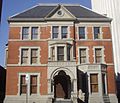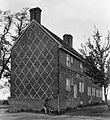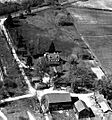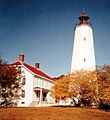List of National Historic Landmarks in New Jersey facts for kids
The National Historic Landmark (NHL) program in the United States is run by the National Park Service. It recognizes special places like buildings, areas, and objects that are super important to the history of our country. New Jersey is home to 58 of these amazing landmarks!
Contents
Cool Historic Places in New Jersey
New Jersey has National Historic Landmarks in 17 of its 21 counties. Mercer County, especially around Princeton, has the most with fourteen!
Here are some of these incredible places:
- Abbott Farm Historic District (Hamilton Township, Bordentown Township, and Bordentown): This is the biggest known ancient Native American village site from about 500 BC to 500 AD. It includes John A. Roebling Park and other nearby areas.
- All Saints' Memorial Church Complex (Navesink): A beautiful stone church built in the Gothic style.
- Atlantic City Convention Hall (Atlantic City): This famous building on the Atlantic City Boardwalk has hosted everything from the Miss America pageant to big wrestling events like WrestleMania.
- John Ballantine House (Newark): This was the home of John Ballantine, from the famous Ballantine brewing family. Today, it's part of the Newark Museum.
- Baltusrol Golf Club (Springfield): This golf club has courses designed by A. W. Tillinghast between 1918 and 1926, which made him a very famous golf course architect.
- Pietro and Maria Botto House (Haledon): This house was a key meeting spot during the Paterson Silk Strike of 1913, a big workers' protest. Now, it's the American Labor Museum.
- Boxwood Hall (Elizabeth): This historic home belonged to Elias Boudinot, who was president of the Continental Congress. George Washington even had lunch here before his inauguration! It was also home to Jonathan Dayton, who signed the Declaration of Independence.
- Burlington County Prison (Mount Holly): When it closed in 1965, this was the oldest prison still operating in the United States!
- Camp Evans (Wall Township): This used to be an important military base.
- Cape May Historic District (Cape May): This whole area is recognized as the country's oldest seaside resort, located at the very southern tip of New Jersey.
- Clark Thread Company Historic District (East Newark): A huge complex of cotton thread mills that played a big role in the growth of textile factories.
- Grover Cleveland Home (Princeton): This was the home of Grover Cleveland after he finished his time as President in the White House.
- Craftsman Farms (Parsippany-Troy Hills): A farm and school started by Gustav Stickley for the Arts and Crafts movement, which focused on handmade goods and simple designs.
- Albert Einstein House (Princeton): This was the home of the famous scientist Albert Einstein after he moved from Germany, until he passed away.
- Fort Hancock and the Sandy Hook Proving Ground Historic District (Sandy Hook): This old coastal artillery base was very important for defending New York Harbor.
- T. Thomas Fortune House (Red Bank): The home of Timothy Thomas Fortune, who was born into slavery but became a leading African American journalist and fought for civil rights.
- Georgian Court University (Lakewood): This beautiful estate used to be the winter home of millionaire George Jay Gould. Now it's a university and has a rare real tennis court – one of only 45 in the whole world!
- Grace Church, Newark (Newark): A historic Episcopal Church designed by Richard Upjohn. The church's organist, Samuel A. Ward, wrote the music for "America the Beautiful."
- Great Atlantic and Pacific Tea Company Warehouse (Jersey City): This nine-story concrete building was once a key part of A&P's food distribution system.
- Great Falls of the Passaic (Paterson): A powerful and dramatic waterfall that was heavily used for power during the Industrial Revolution.
- Hadrosaurus Foulkii Leidy Site (Haddonfield): This is where the first almost-complete dinosaur bones in the world were found in 1858! The dinosaur was named Hadrosaurus foulkii.
- Hangar No. 1, Lakehurst Naval Air Station (Lakehurst): This is the famous place where the Hindenburg airship disaster happened on May 6, 1937.
- Joseph Henry House (Princeton): The home of Joseph Henry, a scientist whose research on electromagnetism helped lead to the electrical telegraph. He was also the first leader of the Smithsonian Institution.
- Hermitage (Ho-Ho-Kus): A stone house where George Washington stayed during the American Revolutionary War. Later, it was where Aaron Burr got married. It's now a museum.
- Hinchliffe Stadium (Paterson): A baseball stadium from the 1930s where Negro league baseball games were played during the Jim Crow era.
- Holland Tunnel (Jersey City and New York, NY): One of the first tunnels designed with special ventilation, it goes under the Hudson River and connects New Jersey to Manhattan.
- Francis Hopkinson House (Bordentown): The home of Francis Hopkinson, who was one of the signers of the United States Declaration of Independence.
- Holmdel Horn Antenna (Holmdel): Scientists Arno Penzias and Robert Wilson used this antenna to discover the microwave background radiation that fills the universe. This discovery helped prove the Big Bang theory and earned them a Nobel Prize for Physics!
- Lawrenceville School (Lawrenceville): A famous boarding school often connected with Princeton University.
- William Livingston House (Union): This was the home of William Livingston, who was a member of the Continental Congress, signed the United States Constitution, and was the first elected Governor of New Jersey. It's now part of Kean University.
- Lucy the Elephant (Margate City): Built in 1882, this six-story elephant-shaped building is the oldest example of "zoomorphic" architecture (buildings shaped like animals).
- Maybury Hill (Princeton): The childhood home of Joseph Hewes, another signer of the United States Declaration of Independence.
- Minisink Archeological Site (Delaware Water Gap NRA): This important archaeological site was a major Munsee Native American community when Europeans first arrived.
- Monmouth Battlefield (Freehold Township): The site of an American victory during the American Revolutionary War, the Battle of Monmouth on June 28, 1778. This is also where the legend of Molly Pitcher began! Battle re-enactments happen here every June.
- Morven (Princeton): Built in 1754 by Richard Stockton (1730-1781), who signed the United States Declaration of Independence. It was the New Jersey Governor's mansion from 1945 to 1982 and is now a museum.
- Nassau Hall (Princeton): The oldest building at Princeton University, and it was the largest building in New Jersey when it was built in 1754. It even served as the home of the American government for a few months in 1783!
- Thomas Nast Home (Morristown): The home of Thomas Nast, one of the first editorial cartoonists. He helped take down corrupt politicians and created famous images like Santa Claus, the Democratic Donkey, and the Republican Elephant.
- Navesink Light Station (Highlands): A lighthouse with two lights that helped guide ships into New York Harbor. It was the first place in the U.S. to use special Fresnel lenses.
- New St. Mary's Episcopal Church (Burlington): This Gothic Revival style church was designed by Richard Upjohn and looks like a church in England.
- Abel and Mary Nicholson House (Elsinboro Township): A rare and well-preserved example of a unique brick building style from the Delaware Valley.
- Old Barracks (Trenton): The only remaining colonial army barracks. Hessian troops were captured here after George Washington famously crossed the Delaware River in December 1776.
- Old Queens (New Brunswick): The oldest building at Rutgers University, a great example of Federal architecture on a college campus.
- Palisades Interstate Park (West bank of Hudson River): This huge park is managed by both New York and New Jersey. It includes 24 parks and eight historic sites, covering over 100,000 acres along more than 20 miles of the Hudson River shoreline.
- Paulsdale (Mount Laurel): The birthplace and home of Alice Paul, a very important leader in the Women's suffrage movement, which fought for women's right to vote.
- President's House (Princeton): John Witherspoon lived in this house while he was President of the College of New Jersey (now Princeton University). He also signed the Declaration of Independence.
- Princeton Battlefield (Princeton): After another battle, General George Washington and the Continental Army fought the British here, leading to a British surrender on January 3, 1777.
- Prospect (Princeton): A beautiful building designed by John Notman. It used to be the official home of the President of Princeton University, and now it's the faculty club. Woodrow Wilson lived here before he became a politician.
- Radburn (Fair Lawn): An early planned community designed to keep cars and people separate. It introduced the idea of the "superblock" in neighborhoods.
- Red Bank Battlefield (National Park): The site of the Battle of Red Bank on October 22, 1777, during the Revolutionary War.
- Ringwood Manor (Ringwood): This was the home of ironmaster Robert Erskine, who worked for George Washington here.
- Sandy Hook Lighthouse (Sandy Hook): This is the oldest working lighthouse in the United States!
- Seabright Lawn Tennis and Cricket Club (Rumson): One of the oldest active tennis clubs in the United States.
- Shadow Lawn (West Long Branch): A huge, fancy home built for the president of the F.W. Woolworth Company. It's now called Woodrow Wilson Hall and is part of Monmouth University.
- Speedwell Ironworks (Morristown): This is known as the birthplace of the electric telegraph!
- Elizabeth Cady Stanton House (Tenafly): The home of Elizabeth Cady Stanton, a key leader in the women's rights movement, from 1868 to 1887.
- William Trent House (Trenton): The home of William Trent, who founded the city of Trenton, New Jersey. Several New Jersey Governors also lived here.
- Washington Crossing State Park (Titusville, NJ and Yardley, PA): This is the New Jersey side of where George Washington's crossing of the Delaware River happened on Christmas night, 1776, before the Battle of Trenton.
- Walt Whitman House (Camden): The last home of the famous American poet Walt Whitman.
Historic Areas in the National Park System
Some historic places are so important that they are already part of the National Park System, like National Historic Sites or National Historical Parks. These places are already highly protected, so they usually aren't also named National Historic Landmarks. New Jersey has four of these special places:
- Paterson Great Falls (Paterson): This powerful waterfall is also a National Natural Landmark and was a key site for mills during the Industrial Revolution. It's also a Civil Engineering Landmark!
- Ellis Island (Jersey City): This famous place was an immigration center from 1892 to 1954, where millions of immigrants entered the U.S. It's part of the Statue of Liberty National Monument.
- Thomas Edison National Historical Park (West Orange): This park includes the laboratory and home (Glenmont) of the famous inventor Thomas Alva Edison.
- Morristown National Historical Park (Morristown): This park protects several important sites from the American Revolutionary War, including the Ford Mansion (where George Washington stayed), Jockey Hollow, Fort Nonsense, and the New Jersey Brigade Encampment Site.
Images for kids
See also



























































